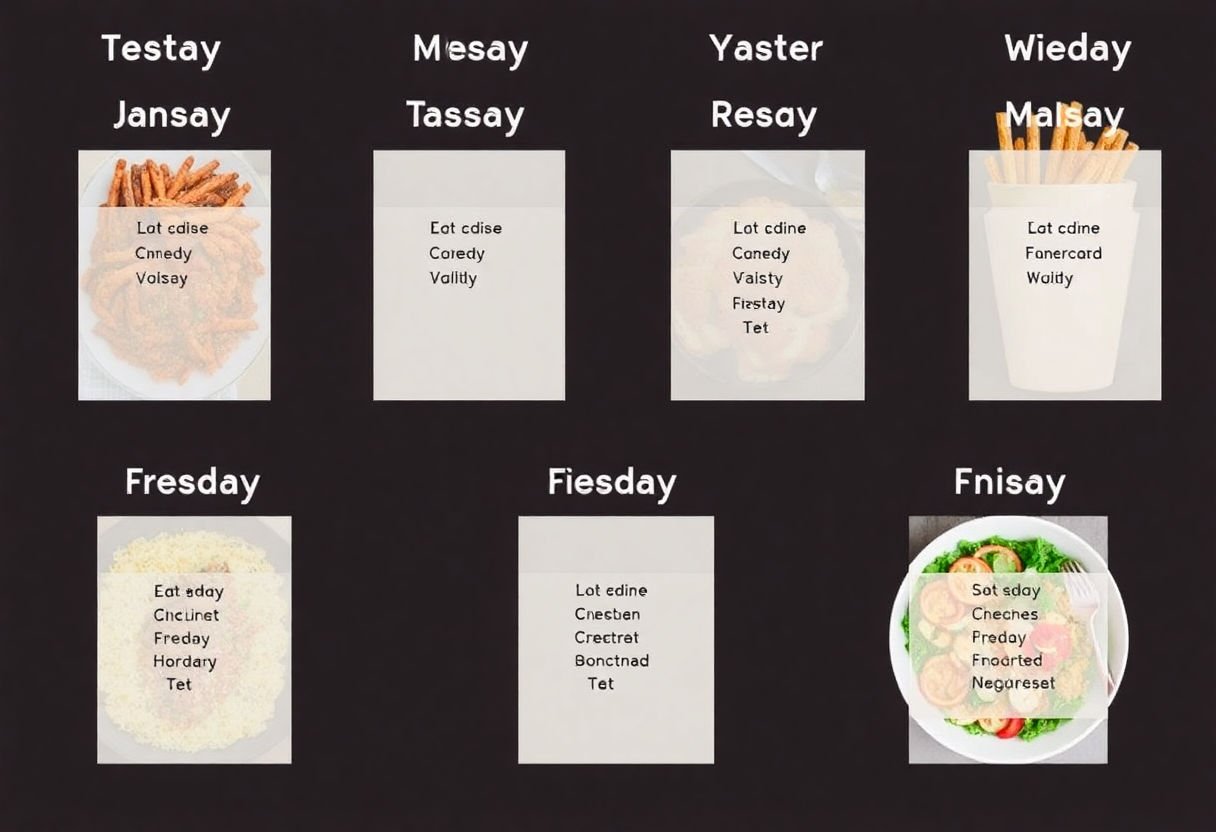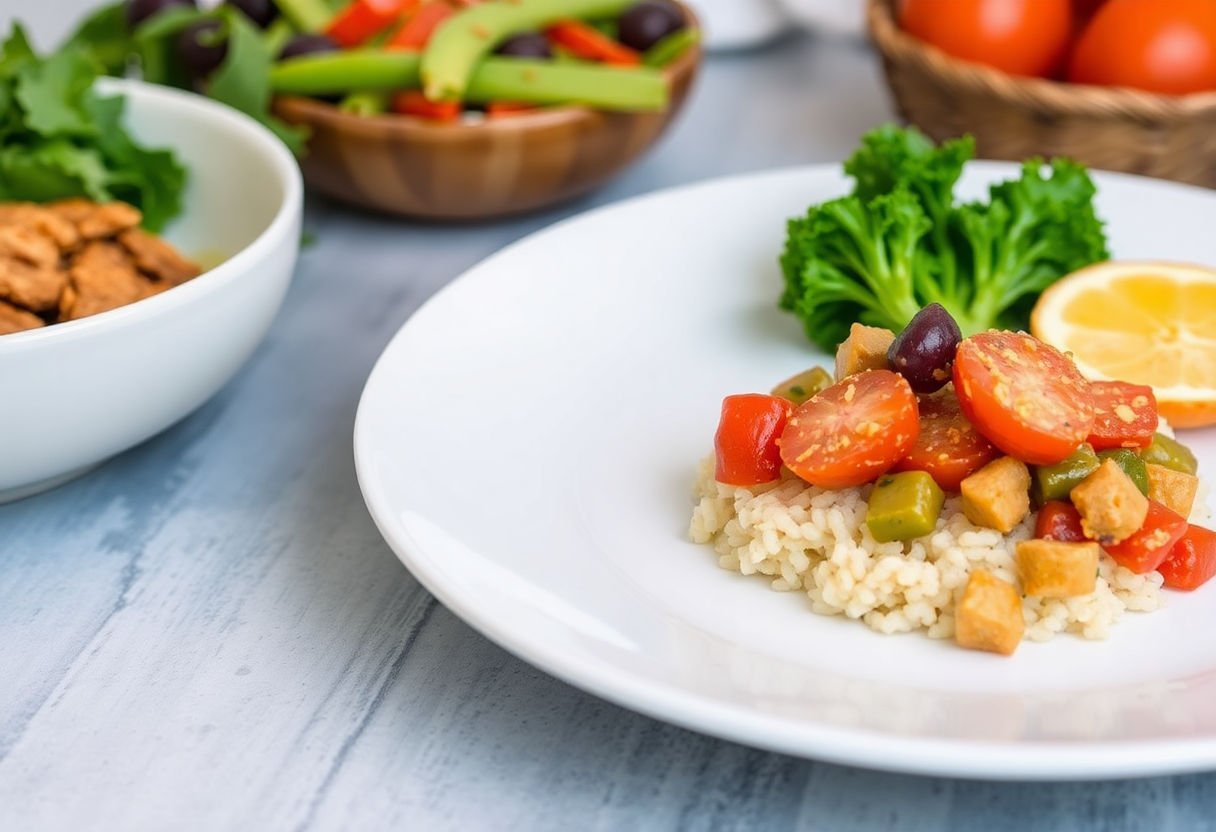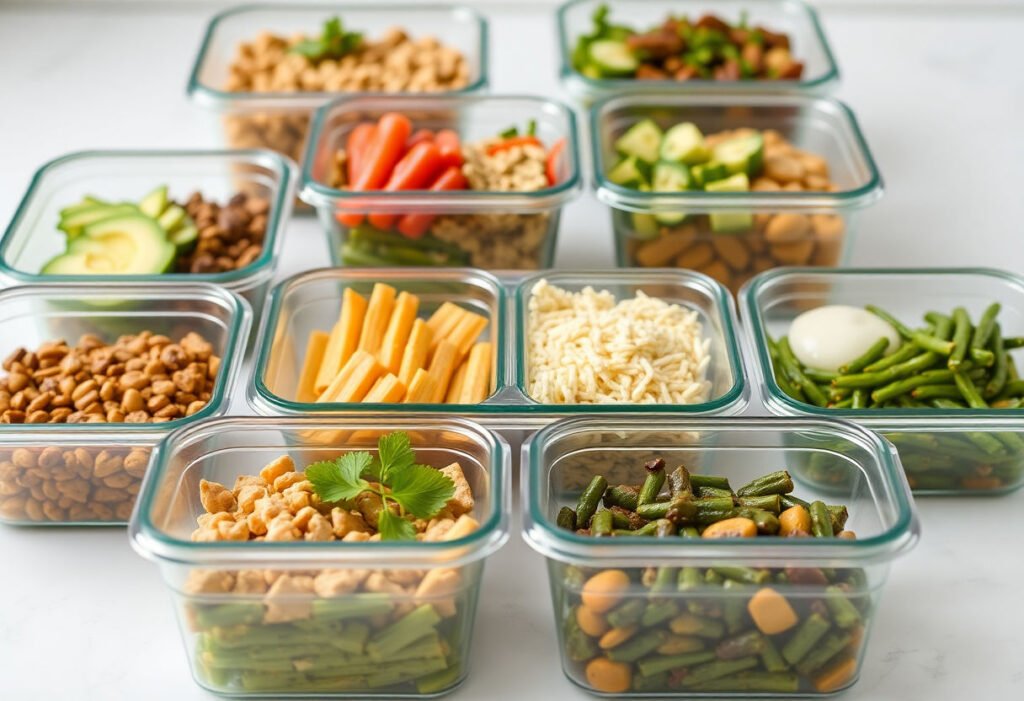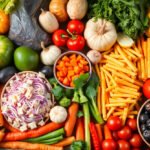Mastering the art of meal prep can revolutionize your weekday cooking routine, transforming mealtime from a stressor into a seamless experience. This article dives into a wealth of strategies for efficient and healthy meal preparation. Discover time-saving techniques, ingredient selection tips, and structured planning guides for balanced meals that satisfy your needs and save valuable time. By optimizing grocery shopping and embracing smart storage solutions, you’ll maintain freshness and quality effortlessly. Embark on this journey to streamline your kitchen practices and achieve healthier eating with minimal effort, all tailored to fit your unique lifestyle.
Key Takeaways
- Efficient meal prepping dramatically reduces weekday cooking time by utilizing smart strategies and techniques.
- Careful ingredient selection enhances both the nutritional value and taste of meals, ensuring a balanced diet.
- Crafting a detailed meal plan in advance simplifies shopping and ensures a perfect blend of flavors and nutrition.
- Quick recipes tailored for meal prepping maintain freshness and quality without compromising on taste.
- Involving family members in the meal preparation process promotes healthy eating habits and shared responsibilities.
Benefits of Meal Prepping

Meal prepping offers several compelling advantages, making it an essential practice for those aiming to streamline their weekdays. First and foremost, time-saving is one of the most significant benefits. By dedicating a few hours during the weekend to prepare meals, individuals can reduce the daily stress of deciding what to cook and save valuable time during busy workdays. This approach allows more time for other important activities, such as exercise or family bonding.
Moreover, meal prepping contributes to better health. Planning meals in advance facilitates more conscious choices about what to include in one’s diet, such as incorporating more fruits, vegetables, and lean proteins. This foresight helps avoid impulsive decisions that often lead to unhealthy eating habits. Consistently consuming balanced, home-cooked meals can lead to improved nutrition and overall well-being.
In addition to health benefits, meal prepping is an excellent tactic for budget management. By purchasing ingredients in bulk and minimizing food wastage, individuals can significantly cut down on grocery expenses. Having prepared meals ready can also reduce the reliance on expensive takeout or dining out.
Finally, meal prepping can contribute to a greater sense of control and organization. Knowing that meals are prepared reduces the daily hassle of cooking, leading to a structured routine and less cluttered mind. This practice can enhance one’s ability to focus on daily tasks without the persistent distraction of meal preparation.
Overall, incorporating meal prepping into one’s weekly schedule offers a myriad of benefits that extend beyond the kitchen and enhance everyday living.
Plan Your Meals Ahead
Planning your meals ahead is an essential strategy in streamlining weekday cooking and ensuring balanced nutrition. Start by allocating time each weekend to craft a comprehensive weekly meal plan. This plan should outline every meal you intend to cook, factoring in dietary preferences and nutritional balance. By establishing this framework, you diminish midweek stress and impulsive decisions that often lead to unhealthy choices.
Organize ingredients by categorizing them into perishable and non-perishable groups. This not only aids in visualizing what you will need but also in managing your pantry efficiently. Perishables such as vegetables, fruits, and proteins should be prioritized for early-week meals to prevent spoilage, while non-perishables like grains and canned goods can be scheduled for later in the week.
Consider creating a master list of your household’s favorite meals and rotate them periodically; this minimizes decision fatigue and ensures variety. Incorporating a mix of familiar recipes and new culinary adventures can make meal planning an enjoyable task rather than a chore.
To enhance meal prepping efficiency, utilize a structured approach with meal components like grains, proteins, and vegetables. Prepare these components separately at the beginning of the week, allowing for flexible, mix-and-match meal creation. For instance, batch-cooked quinoa and roasted chicken can become part of a salad, grain bowl, or wrap, diversifying your options from a few staples.
In the words of famed chef Julia Child, “You don’t have to cook fancy or complicated masterpieces—just good food from fresh ingredients.” Embrace this philosophy and make meal planning an invaluable tool in your culinary repertoire.
Efficient Grocery Shopping Tips
Creating an efficient grocery shopping routine can significantly streamline your meal prep process. Here are some essential tips to consider:
-
Draft a Detailed List: Before heading to the store, create a comprehensive list based on your pre-planned meals. Categorize items by section, such as produce, dairy, and pantry staples. This reduces the risk of impulse buys and ensures nothing is overlooked.
-
Check Pantry and Fridge Stocks: Conduct a quick inventory of your current supplies. This helps avoid duplicating purchases and waste, saving both time and money.
-
Stick to Seasonal Produce: Purchasing fruits and vegetables in season can lead to better prices and quality. Seasonal produce also encourages variations in meals, keeping your diet diverse and appealing.
-
Opt for Bulk Purchases: Non-perishable items like grains, pasta, and canned goods are often cheaper in bulk. This strategy is particularly advantageous for those who consistently use certain staples, enhancing both efficiency and budget management.
-
Embrace Technology: Consider using grocery list apps that can sync across devices. These applications often include features that allow you to categorize, prioritize, and adjust your list easily.
-
Set a Regular Shopping Schedule: Consistency is key in maintaining a stocked kitchen. Establish a routine, such as weekly shopping trips, to ensure you always have necessary ingredients on hand for your meal prep sessions.
-
Utilize Store Layout: Familiarize yourself with the layout of your preferred grocery store. Knowing the fastest route to navigate through aisles can cut down on shopping time significantly.
Implementing these strategically crafted tips can transform grocery shopping from a time-consuming chore into a swift, organized task, thereby enhancing the overall meal prep experience.
Quick and Nutritious Recipes

For those navigating the hustle and bustle of weekday commitments, having a repertoire of quick and nutritious recipes is invaluable. These recipes are designed to balance flavor and nutrition, ensuring each meal provides essential nutrients without requiring hours in the kitchen.
Power Breakfast Smoothie
Start your day with a Power Breakfast Smoothie, blending together high-protein yogurt, fresh berries, spinach, and a tablespoon of chia seeds. This nutrient-packed drink not only boosts energy but also takes less than five minutes to prepare.
One-Pan Quinoa and Veggies
Lunchtime can be streamlined with a One-Pan Quinoa and Veggies dish. Sauté an assortment of your favorite vegetables with pre-cooked quinoa and season with a dash of olive oil, lemon, and herbs. This hearty dish is both filling and incredibly versatile, allowing for substitutions based on seasonal availability.
Grilled Chicken Salad
For dinner, a Grilled Chicken Salad offers a satisfying and nutritious option. Marinate chicken breasts in a simple olive oil, lemon juice, and garlic mixture, then grill to perfection. Serve atop a bed of mixed greens with cherry tomatoes, cucumber slices, and a sprinkle of feta cheese. Finish with a drizzle of balsamic vinegar for a tasty, well-rounded meal.
Sweet Potato and Black Bean Tacos
Finally, Sweet Potato and Black Bean Tacos are a delightful choice that caters to all dietary needs. Roast sweet potatoes with cumin and chili powder, then mix with black beans for a fiber-rich filling. Serve in corn tortillas topped with avocado, cilantro, and lime juice for a burst of fresh flavor.
These recipes serve as a framework, encouraging creativity while ensuring every meal remains quick and nourishing.
Smart Storage Solutions
Storing prepped foods efficiently ensures they remain fresh and preserve their taste and nutritional quality. Implementing smart storage solutions can significantly enhance the success of your meal prep endeavors.
Begin by choosing the right containers. Glass containers are highly recommended due to their durability, ease of cleaning, and the fact that they do not absorb odors. Additionally, their transparency makes it easier to identify contents. These containers should come in different sizes to accommodate various portions and types of meals.
Temperature control is crucial for maintaining food quality. Store perishable items such as cooked meats, dairy, and prepared vegetables in the coldest part of the refrigerator. It’s essential to set your refrigerator’s temperature to below 40°F (4°C). Consider using refrigerator bins or drawer dividers to create zones for specific food categories, which can help in quick access and reducing cross-contamination.
Labeling is another effective tool for organization. Use labels to mark containers with the name of the meal and the preparation date. This practice helps manage shelf life and rotation, ensuring you consume older items first, reducing waste.
Another smart tip is to freeze meals or ingredients in single-serving sizes. This allows for quicker defrosting and reduces the likelihood of food spoilage. When freezing, use freezer-safe bags or vacuum seal bags to minimize exposure to air, preventing freezer burn and retaining flavors.
By implementing these strategic storage practices, you can seamlessly enhance the quality and lifespan of your prepped meals, making busy weekdays more manageable and efficient.
Batch Cooking Techniques
Batch cooking is a highly efficient strategy for simplifying weekday meals while ensuring diversity and nutrition. This technique involves preparing large quantities of food at once, which can then be divided into portions for use throughout the week, effectively optimizing both time and resources.
One effective method for batch cooking is to focus on versatile staple ingredients such as grains, proteins, and vegetables. Cooking grains like rice, quinoa, or barley in bulk ensures you have a base ready to pair with different proteins and sauces, enhancing your weekly meal variety. Importantly, proteins like chicken, beef, or plant-based options can be seasoned and cooked in bulk, then divided into smaller meal portions. Using methods like roasting or slow-cooking not only enhances flavor but also preserves tenderness and moisture.
Soup and stew preparation is another excellent batch cooking strategy. These meals can be made in large volumes and stored in individual portions, providing a quick, warming meal option that requires minimal reheating. Similarly, making large batches of vegetable-based sauces or purees can add quick flavor to any meal, allowing for culinary creativity throughout the week.
Adopting an organizational approach to batch cooking can further enhance efficiency. Using consistent portioning, clear labeling, and strategic storage techniques—such as utilizing freezer-safe containers—ensures that cooked meals retain their quality and flavor. By organizing meal components in this way, you simplify the daily mealtime decision-making process, minimizing stress and maximizing enjoyment for busy weekdays.
In essence, batch cooking is a practical and reliable method for maintaining a fresh, nutritious, and varied diet that suits the fast-paced lifestyle of the modern professional.
Involving Family in Meal Prep

Engaging family members in meal preparation is a creative way to enhance both efficiency and enjoyment in the kitchen. Collaborating on meal prep not only distributes the workload but also serves as a platform for bonding and learning.
Start by assigning age-appropriate tasks to each family member. Younger children can help with washing fruits and vegetables, setting the table, or rinsing grains. Older kids might engage in more detailed work such as chopping vegetables or assisting in measuring ingredients. These activities foster skills while building a sense of contribution.
Introduce themed nights to make meal preparation engaging. Whether it’s a taco night or homemade pizza extravaganza, having a theme instills excitement. This approach encourages creativity and allows family members to experiment with toppings, spices, and flavors, resulting in diverse and personalized meals.
Create a meal prep calendar, allocating specific days and roles for grocery shopping, prep, and cooking. This organized approach prevents last-minute rushes and ensures everyone is aware of their responsibilities. A visible calendar can also serve as a motivational tool, providing a visual reminder of the week’s culinary journey.
Nurturing an interest in cooking, particularly among children, has long-term benefits. By involving family in meal prep, you are not only alleviating immediate mealtime stress but also instilling healthy eating habits. This investment in kitchen time translates into increased culinary confidence and competence, ultimately leading to a healthier and more connected family dynamic.
Adapting Meal Prep to Dietary Needs
To effectively adapt meal prep to various dietary needs and restrictions, it’s essential to integrate strategies that cater to specific nutritional requirements without compromising on taste or convenience.
Identify Dietary Restrictions: Begin by clearly identifying any dietary restrictions you need to accommodate, such as gluten-free, vegan, vegetarian, keto, or low-sodium diets. Understanding these needs helps in selecting and preparing ingredients that align with the diet’s guidelines.
Ingredient Substitutions: Use smart substitutions to create meals that fit dietary needs without sacrificing flavor. For instance, replace wheat-based products with gluten-free alternatives, or use plant-based proteins like tofu and legumes for vegan diets. Almond milk can replace dairy in most recipes, providing a creamy texture without the lactose.
Batch Cooking Adaptations: When batch cooking, consider preparing staple items that can be customized later according to individual dietary preferences. For example, cook a large batch of quinoa or brown rice, then separate it into smaller portions to add different proteins or vegetables depending on the dietary requirements.
Balanced Nutrition: Ensure your meal prep includes a variety of nutrients by incorporating colorful fruits and vegetables, whole grains, and lean proteins. For those following specific diets like keto, adjust the macronutrient balance accordingly, focusing on high-fat, moderate-protein content.
Read Labels Carefully: When purchasing packaged foods, meticulously read labels to avoid hidden ingredients that may not align with the dietary plan. This is especially important for those with allergies or intolerances.
Adapting meal prep to suit dietary needs is not just about exclusion but also about creatively incorporating alternative ingredients to deliver delicious, balanced meals that everyone can enjoy.
Conclusion
Incorporating effortless meal prep hacks into your routine can transform weekday cooking from stressful to seamless. By mastering techniques like effective batch cooking and smart storage solutions, you save invaluable time and maintain a balanced diet. As more households embrace the benefits of planning meals ahead, not only is there potential for greater health and budgetary improvements, but also the opportunity to foster family collaboration. Begin integrating these strategies today and witness increased efficiency and enjoyment in your culinary endeavors.
Frequently Asked Questions
How long can meal-prepped food be stored in the refrigerator?
Meal-prepped food can typically be stored in the refrigerator for three to five days. To ensure freshness and safety, it’s essential to use airtight containers and set your refrigerator to the proper temperature.
Is meal prepping cost-effective?
Yes, meal prepping can be cost-effective because it allows you to buy ingredients in bulk and reduce food waste. By following a structured meal plan, you can avoid unnecessary grocery trips and impulse buying.
Can meal prep support weight management goals?
Meal prepping can be a fantastic tool for supporting weight management goals. By carefully selecting portions and ingredients in advance, you maintain control over what you eat, which can contribute to healthier choices and portion sizes.
How do I keep meal-prepped food from getting boring?
To keep meal-prepped food exciting, incorporate a variety of flavors and textures by using different herbs, spices, and sauces. Rotational planning with diverse recipes prevents monotony and keeps meals enjoyable.
Are there specific foods that are best for meal prepping?
Foods that retain quality over time, such as grains, lean proteins, and most vegetables, work well for meal prepping. Avoid delicate greens and other foods prone to spoilage to maintain the best taste and texture.


